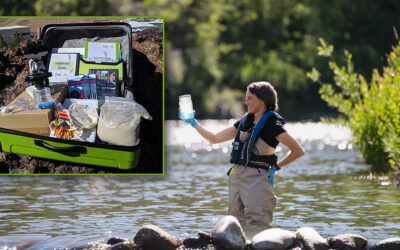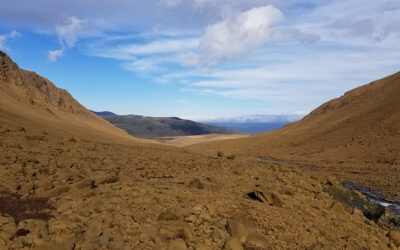Las Vegas, NV (November 1, 2018): The Desert Research Institute, in partnership with the Bigelow Laboratory for Ocean Sciences and University of New Hampshire, announced receipt of a $6 million National Science Foundation grant today that will fund the development of new genetic research technologies and build economic capacity in Nevada, Maine, and New Hampshire.
The multifaceted effort, which the researchers will launch next week at the National Science Foundation in Washington, D.C., aims to unlock the genomic data of microscopic organisms that help to degrade environmental contaminants and drive major biogeochemical cycles that shape global climate.
“There has been an explosion of genomics data over the last two decades, and the next step is connecting that data to what’s actually happening in the environment,” said Ramunas Stepanauskas, Ph.D., director of the Single Cell Genomics Center at Bigelow Laboratory and principal investigator on the project. “We need new infrastructure and approaches to harness the power of genomic technologies, which will help solve some of the great biological mysteries of our planet.”
Single-celled organisms make up the vast majority of biological diversity on our planet, but many are found in hard-to-access places such as the Earth’s subsurface or deep ocean environments, can’t be seen with the naked eye, and can’t yet be grown in lab cultures. As a result, much about these organisms – including their potential for production of natural products for bioenergy, pharmaceuticals, bioremediation, and water treatment – remains unknown.
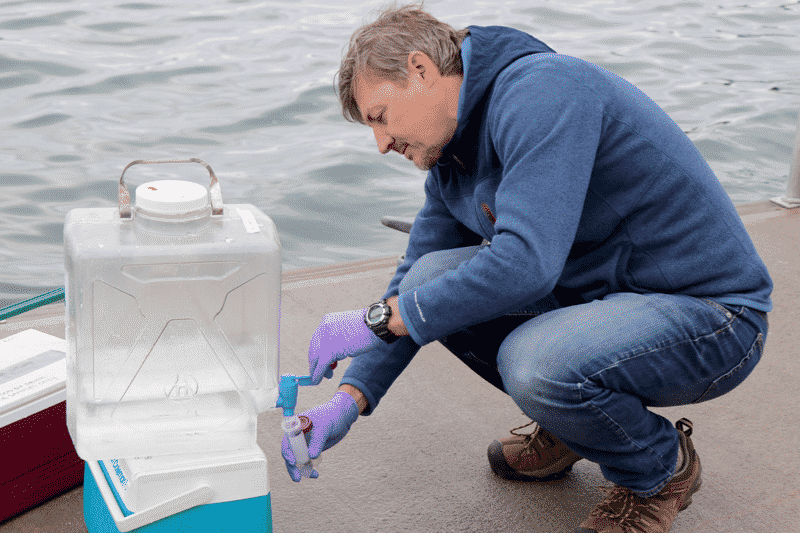
Bigelow Laboratory scientist Ramunas Stepanauskas collects a water sample on the institute’s dock. He is the principle investigator on a new $6 million project that will connect the genetic makeup of individual microbes to their environmental roles and build economic capacity in Maine, New Hampshire, and Nevada. Credit: Bigelow Laboratory for Ocean Sciences.
This four-year project will develop and apply new tools and techniques in genetic analysis to learn about links between the genomes (DNA, or genetic material) and phenomes (observable characteristics) expressed by single-celled organisms in diverse marine and continental environments. The main technical innovation of this project is that information is gained at the level of the individual cell sampled directly from the environment in near-real-time.
To achieve their objectives, the team will gather microbes from coastal ocean habitat in the Gulf of Maine, deep ocean and marine subsurface habitat along the Juan de Fuca Ridge of the northwestern Pacific Ocean, and terrestrial deep subsurface habitat in boreholes that intersect geological fault zones associated with Death Valley, Calif.
Duane Moser, Ph.D., head of DRI’s Environmental Microbiology and Astrobiology Labs in Las Vegas, will lead portions of the project related to the continental subsurface. Moser specializes in microbial and molecular ecology, and has studied microbes of deep underground environments in locations ranging from mines of South Africa, Canada, and the U.S., to caves, especially at Lava Beds National Monument of northern California, to deeply sourced springs from around the Great Basin.
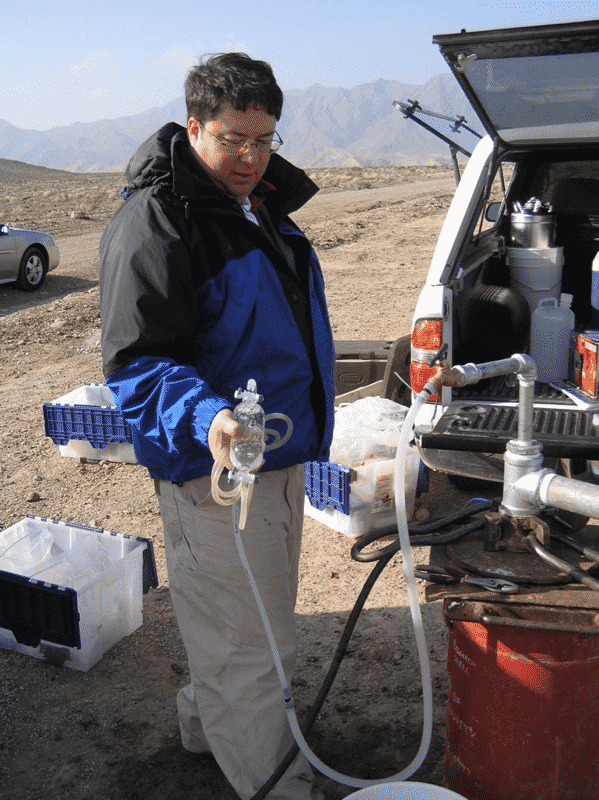
DRI scientist Duane Moser collecting dissolved gas samples from the main project borehole near Death Valley, CA. Credit: Duane Moser/DRI.
The deep subsurface appears to serve as a unique repository for microbial diversity, preserving an evolutionary legacy that may range back to the early stages of cellular evolution, says Moser.
“Evidence continues to mount that the deep subsurface can be regarded as its own distinct biome, yet we lack the tools to determine how rock-hosted life persists in isolation over geologic timescales,” Moser said. “This project promises to not only teach us about the identities of to-date mysterious groups of microorganisms, but literally allows us to eavesdrop on the activities of individual cells in mixed communities from deep underground. That is truly unprecedented.”
Moser is also leading a task aimed at adapting the new technologies for the applied science of environmental bioremediation, using polyacrylamide as a test case. Polyacrylamide is a ubiquitous substance found in consumer products and used for drinking water treatment, amendment for agricultural soils, well drilling and fracking, and as a sealant for unlined irrigation canals. While generally considered non-toxic, commercial polyacrylamide preparations contain residues of acrylamide monomer, which do possess toxic properties.
“Microorganisms have a role in the degradation of most manmade contaminants, yet our mechanistic understanding of these essential transformations is largely limited to laboratory studies of a handful of easily cultured bacteria,” Moser said. “These new tools will enable us, for the first time, to identify and track the activities of the real actors behind the environmental degradation of contaminants.”
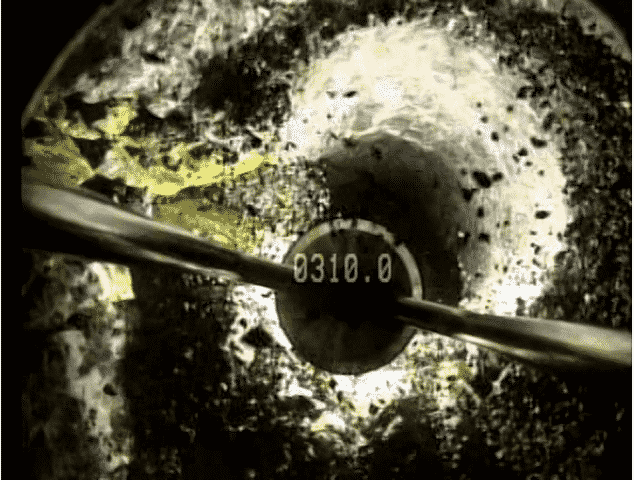
Image taken from within a naturally flowing artesian borehole in Death Valley, Calif., which will be utilized for the testing of experimental equipment prior to undersea deployment at the Juan de Fuca Ridge in the Pacific Ocean. Credit: Michael King, Hydrodynamics Group, LL.
The project funds come from the Established Program to Stimulate Competitive Research (EPSCoR), which aims to strengthen the research and technology capacity of states that have historically received low federal research funding. The project leverages Bigelow Laboratory’s state-of-the-art capacity in single cell genomics and flow cytometry, University of New Hampshire‘s expertise in polymer chemistry and synthesis of fluorescently labeled tracer molecules, and the Desert Research Institute’s experience and infrastructure for studying subsurface environments and contaminants of emerging concern.
“Combing single-cell genomics with measurements of microbial metabolism will help us better understand the role of microbes in cycling biologically important compounds,” said Kai Ziervogel, Ph.D., the microbial biogeochemist leading project efforts at University of New Hampshire. “I am excited that this project will provide undergraduate and graduate students opportunities to participate in interdisciplinary research that will contribute to environmental science in a unique way.”
In addition to creating new research infrastructure, the project will spur economic growth through skilled workforce training opportunities and several new jobs – including a new postdoctoral scientist at the Desert Research Institute, new senior research scientist and postdoctoral positions at Bigelow Laboratory, as well as a faculty member at University of New Hampshire. The research team will also provide professional development opportunities, including the training of graduate students and bioinformatics workshops in Maine, New Hampshire, and Nevada.
“As we improve our understanding of the critical functions of life, we can also improve our three collaborating states,” Stepanauskas said. “By enabling novel research, educational programs and workforce development, this work will have broad impact on the research community and beyond.”
Rachel Kaplan and Steven Profaizer from Bigelow Laboratory for Ocean Sciences contributed to this release.
###
The Desert Research Institute (DRI) is a recognized world leader in basic and applied interdisciplinary research. Committed to scientific excellence and integrity, DRI faculty, students, and staff have developed scientific knowledge and innovative technologies in research projects around the globe. Since 1959, DRI’s research has advanced scientific knowledge, supported Nevada’s diversifying economy, provided science-based educational opportunities, and informed policy makers, business leaders, and community members. With campuses in Reno and Las Vegas, DRI serves as the non-profit research arm of the Nevada System of Higher Education. Learn more at dri.edu, and connect with us on social media on Facebook, Instagram and Twitter.
Bigelow Laboratory for Ocean Sciences is an independent, nonprofit research institute on the coast of Maine. Its research ranges from the microscopic life at the bottom of marine food webs to large-scale ocean processes that affect the entire planet. Recognized as a leader in Maine’s emerging innovation economy, the Laboratory’s research, education, and technology transfer programs are contributing to significant economic growth. Learn more at bigelow.org, and join the conversation on Facebook,Instagram, and Twitter.
The University of New Hampshire (UNH) is a public research university in the University System of New Hampshire. With over 15,000 students between its Durham, Manchester, and Concord campuses, UNH is the largest university in the state. The School of Marine Science and Ocean Engineering, the heart of UNH’s oceanographic research, is the university’s first ‘interdisciplinary school’, designed to address today’s highly complex ocean and coastal challenges through integrated graduate education, research and engagement. As such, it serves as an interdisciplinary nexus for marine science and ocean engineering teaching and research across the University. Learn more at www.marine.unh.edu
